#stud history
Explore tagged Tumblr posts
Text
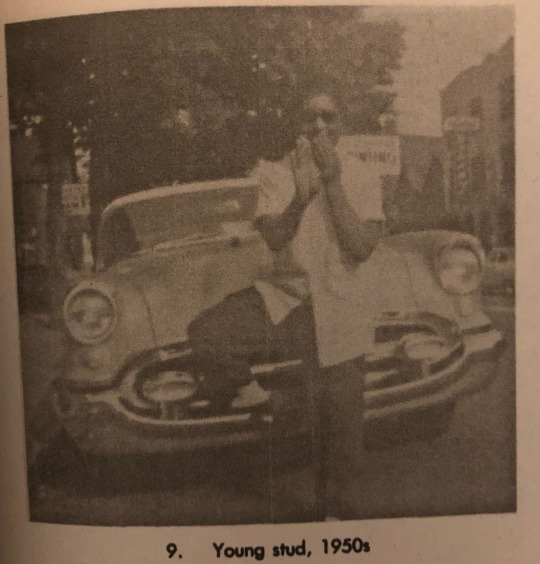
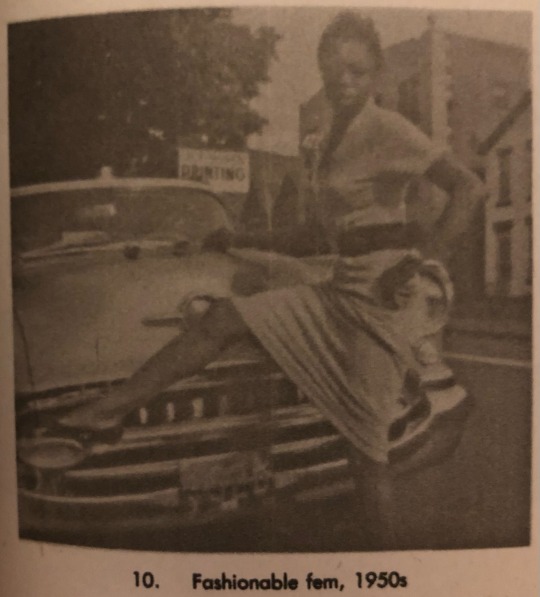
Source: Boots Of Leather , Slippers Of Gold; The History Of A Lesbian Community - by Elizabeth Lapovsky Kennedy and Madeline D. Davis
#black lesbian positivity#black lesbian history#stud positivity#stud history#black femme history#black femme positivity#lesbian fashion#lesbian history#lesbian positivity#wlw#sapphic#lgbt#image#lesbian#photo#personal
628 notes
·
View notes
Text






from “Masculine of Centre, Seeks Her Refined Femme” by B. Cole on the history of the term masculine of center
published in Persistence: All Ways Butch & Femme, ed. Ivan E. Coyote & Zena Sharman (2011)
excerpt 1:
[…] that was supposed to look like, and the word never fully reflected who I am. One of my first conversations with Oshen T., an activist and she-pronoun-using stud, echoed this unease with which many of us take up the mantle of butch.
I identify as stud but, growing up, I didn’t know that there was a word, “stud.” What was more common was butch, but at some point, like in my mid to late teens, I noticed that butches were usually white women, and even though I did see some black butches … at some point it got really irritating and didn’t fit me. I don’t feel butch, and I don’t like that word, even saying it. Stud came out of me and my peers having a conversation, and I held onto the word stud. We younger studs from East Oakland started to gravitate toward that. Butch was white and older, and as young kids, we were studs. There was some age stuff, race and class. All the books were about stone cold butches … just white people. We were like, nah, that’s not us. —Oshen T.
If butch wasn’t the word I was looking for, what was it? Should I use dom? Stud? AG (aggressive)? None of these quite worked, and so in 2008 I introduced the term “masculine of centre” (MoC) as more encompassing and less racially and class-specific than butch. MoC also speaks to the cultural nuances of female masculinity, while still recognizing our commonalities—independent of who we partner with. The inclusion of the language “of centre” sees beyond the traditional binary of male and female to female masculinity as a continuum. “Of centre” is a way of acknowledging that the balance each of us determines around our own masculinity and femininity in the discovery of our gendered selves is never truly fixed. Masculine of […]
excerpt 2:
Unlike white female masculinity, female masculinity for womyn of colour is based on sites of power and systemic oppression—through masculinities of colour. The assumption that they can be resignified with equal subversive and revolutionary actions against white manhood is false. The ability to access masculinity pivots upon the ways in which gender intersects with race, and these gaps have been filled with many new ways of naming ourselves. In the last decade, the explosion of young masculine-of-centre womyn has created a demographic shift on the butch landscape, giving way to terms like “stud,” “boi,” “tom,” and “macha” in California and the South, “dom” within the DC, Maryland, and Virginia region, and “aggressives,” or “AGs” in New York.
excerpt 3:
Attempts to disrupt this sense of “classical” butch continue to rely on representations and cultural location within whiteness and white notions of masculinity and femininity. As Halberstam points out, there is cultural value in marginalizing masculinities that divert from the master narrative. Even though Halberstam is speaking to heteronormative masculinity here, these diverting narratives have the potential to “dilute” the “authoritative power” of white butchness in the same way. As this narrative is pushed into the mainstream queer consciousness to construct butch identity, many of our experiences are left out. Supporting versions of masculinity that we enjoy and trust, many of these “heroic masculinities” depend absolutely on the subordination of alternative masculinities.”
excerpt 4:
The title of this piece, “Masculine of Centre, Seeks Her Refined Femme,” is a heading from the first dating profile posted using the term “masculine of centre.” It speaks to both a historical legacy of butch-femme and a longing for a language different and new.
excerpt 5:
The emergence of this new language would not have happened were it not for the ways in which masculine-of-centre womyn of colour live their female masculinity through the lens of race. Our identity has socially transformative powers and there are still nuances to our identities—masculine-of-centre mothering, social mobility, and historical racial oppression—which shape masculinity in [ways that have yet to be fully explored.]
#masculine of center#masculine of centre#queer masculinity#queer history#b cole#MoC#stud#stud history#quotes#image described#mac’s bookshelf
2 notes
·
View notes
Text

"Lesbian Weddings" by Wendy Jill York
source: The Femme Mystique, edited by Lesléa Newman
#lesbian literature#lesbian#dyke#thatbutcharchivist#archived#lesbian books#lesbian history#lesbian photography#black lesbian#black femme lesbian#black femme#black butch lesbian#black butch#stud lesbian#i pray i am using the term stud appropriately here#will edit if not#author: lesléa newman#year: 1995#publisher: alyson publications inc.#the femme mystique#photographer: wendy jill york#black lesbian couple#black couple#the gal on the left looks a little like my sister tsega ... i miss her so much 😭😭😭#femme4butch#femme4stud#butch4femme#stud4femme#femme#butch
28K notes
·
View notes
Text

#lesbian history#nonbinary lesbian#masc lesbian#femme lesbian#black lesbian#lesbian art#butch lesbian#stud lesbian#soft butch#lesbian#lesbian artist
897 notes
·
View notes
Text

Such a amazing transgender woman! She's just PERFECT!!!
#transgender#queer#trans community#transgirl#trans pride#transgenderwoman#lgbtlove#transfem#lgbtqia#trans#lgbt#lgbt pride#lgbtq artist#lgbtq people#lgbtq history#lgbtq positivity#lgbtqia+#lgbtq#lgbtqplus#lgbt nsft#lgbtq community#queer community#bisexual#gay fashion#queer fashion#queer fashion#trans fashion#lesbian day of visibility#stud lesbian#t4t lesbian
609 notes
·
View notes
Text
Fish Flag


Original Flag, Inspiration, and Palette by @estrogenism (Thank you for the permission to edit this flag!)
What does Fish mean?
Fish is a black exclusive term for a femme lesbian. This label was first recorded as a counterpart the label 'Stud' in a Masters of Arts thesis titled, 'A Study of a Public Lesbian Community' by Ethel Sawyer. Black masculinity is to Stud as Black femininity is to Fish.
The Flag: Symbols and Colors
School of Black Fish: In the original flag I found on my dash, estrogenism uses an image of a tropical fish to represent the body diversity among black femmes. I decided to go with a school of fish to represent the community among black femmes. Initially, I wanted the school to look like a crescent moon to represent femininity further, but I wasn't fuckin' with it.
Colors:
The darkest purple: Womanism (a feminist school of thought centered around the black experience)
2nd darkest purple: Black sapphicism
2nd lightest purple: Black sapphic history
Lightest purple: Unity between all fish (trans, cis, intersex, aspec, arospec etc)
Lightest pink: Subversion of femininity
2nd Lightest Pink: Vulnerability (????)
Orangey-Pink: Persistence
Red: Love
Recommended Reading
Femme: Feminists, Lesbians, and Bad Girls (Edited by Laura Harris and Elizabeth Crocker) [There are two relevant segments. Fish Tales and Fish Pond]
A Public Study of a Lesbian Community by Ethel Sawyer (This study was done by a heterosexual woman. Due to the time it is from, harmful stereotypes of both studs and fish are portrayed in this thesis. These misconceptions are incredibly dated.)
Note: Based on the reading that I have done (Including the original thesis itself), some bisexual women were involved in the lesbian bar culture and identified with the label Fish. Out of the 7 fish interviewed by Sawyer, 2 out of 7 (28%) enjoyed sex with men. That being said I don’t mind or care if black bisexual femmes use this flag. But please understand the difference between presenting femininely and femme culture within the sapphic context (specifically butchfemme/studfemme/stud-fish community) before using this label.
THIS IS THE FIRST FLAG I MADE SO PLEASEEEE BE KIND
Software/Website used: Canva (Design and Assets) and Coolors (palette picking)
#lesbian#sapphicism#fish lesbian#fish4stud#fish4bulldagger#fish4butch#stud-fish#femme lesbian#queer femme#femme bait#black qwoc#black queerness#black lgbt#black femme lesbian#black femme#femme posting#femme positivity#dykeposting#lesbianism#lesboposting#pride flag#lgbtq+#qtpoc#qwoc#qwoc history#butchfemme#black butchfemme#black sapphic#lesbian terminology#macbxth’s flags
136 notes
·
View notes
Text
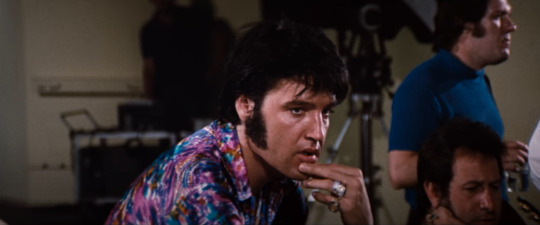

July 1970. Elvis Presley during rehearsals at MGM's Studios in Culver City, CA. "Elvis: That's The Way It Is"


#70% of the time I look at him I'm holding myself back from screaming#the other 30% i'm feeling shivers#adorable little fucker#he switches from a sweet little boy to a stud looking man so fast#ahhhhhhhh#i love himmmmmmmm#and i hate him for making me feel those things too when i can't ever meet him#why god why#elvis presley#elvis history#elvis that's the way it is#1970#elvis#70s elvis#elvis the king
67 notes
·
View notes
Text
Comparing Twitter and tumblr queer culture is so amusing
Twitter queer culture: reminder that if you’re an mspec lesbian every character from honkai star rail hates you (?)
Tumblr queer culture: does anyone know if we have butch faggot joy tomorrow
#do not look up mspec lesbian on twitter worst mistake of my life#It’s all just a bunch of exclus bullshit that blatantly disrespects history#Meanwhile on tumblr if you search mspec lesbian most of the posts are positive#Which is a good thing#my favorite thing is when I see posts with lots of notes about fag and dyke solidarity and stuff#I personally think that bi dykes and lesboys and turigirls and bears and butches and femmes and studs bring happiness to the world#Not to mention transsexual joy#Btw do we also have transsexual joy tomorrow? Asking for a friend#lgbtq#queer#e#This is a scheduled post
111 notes
·
View notes
Text
A Brief Look at Stem(me) History
Wanted to know more about Black lesbian identities and I couldn't find a lot on Tumblr or Twitter so I did some research on stem/stemme myself. I'm not involved in queer discourse like that but I've noticed stemme being compared with futch both positively an negatively. The term "futch" is a mash up of butch and femme and the OG Futch Scale was posted 17th February 2011. In 2015, it got posted to Tumblr and became a meme, then an accidental "guide" on lesbian identity. Regardless of stances pro-futch or anti-futch I wanted to find info on stem/stemme as a Black lesbian identity for gender and gender expression. The modern definition of a stem/stemme is a Black lesbian whose gender expression and mannerisms fall between stud and femme. I've managed to find definitions not only supporting this but also definitions predating the futch scale, both pre and post meme version:
"Stem – A person whose gender expression falls somewhere between a stud and a femme. (See also ‘Femme’ and ‘Stud’.)" Stud is defined as "An African-American and/or Latina masculine lesbian. Also known as ‘butch’ or ‘aggressive’." (John Jay College of Criminal Justice LGBTQ+ Terminology, Eli R. Green, 2003-2004)
"Stemm A stemm is a gay/lesbian female who dresses like a guy, and dresses like a girl. Person 1: Look at that girl, she looks like a dude with all those guy clothes on, she has to be a stud Person 2: Well she was wearing girly clothes yesterday, so I thought she was a femm Person 3: Actually she's a stemm, she's wears boy clothes sometimes, and girl clothes other times" (Urban Dictionary definition of Stemm by user JenniferHill, November 8th 2009)
"A lesbian, who identifies as a Stemme, retains traits from both Femme and Stud/ Butch lesbians. Stemmes are in the center of the lesbian spectrum of classification and identities. Therefore, it is considered natural or common for Stemme lesbians to share the same behaviors as women of two diverse identity groups. Often times, the Stemme identity is viewed as the “transitional” stage of lesbianism, when a lesbian woman goes from being a Femme to a Stud/ Butch, or (on rear occasions) from a Stud/ Butch to a Femme... *In this blog the characteristic and behavioral difference between a Femme and a Stud is conjoined. The way a Femme or a Stud dresses is not the only way she can be identified. They can also be distinguished by their attitudes, actions and the way they interact with other people. A Stemme is the in-between identity of a Stud and Femme. She is apart of both groups and her identity is subject to change at anytime. A Stemme identity is often referred to as the transitional stage; however, some lesbian women remain a Stemme because they enjoy representing male and female dominance." (Lesbian Identity: Stemme, Nell S., 6th Nov 2009)
"'one who could switch up one day, she could be a femme and other occasions dress like she has a li’l hood, li’l ghetto inside her; a stemme – part femme part stud a tomboy'" (STORY OF INTEREST: Lesbian Speaks Out, Dominica News Online, April 12th 2010)
"Stemmes presented themselves one day as femme and another day as stud; as such, they were visibly unrecognisable unless they divulged their gender identity. Stemmes expose the amorphous nature of gender identity and are invisible – silenced, ostracised or prescribed a gender identity. Many participants refused to recognise that stemmes existed and instead described them as confused. As Shane (age 22) admitted: ‘Sometimes they [studs and femmes] think that we’re confused. We don’t know what we want to be.’ Stemmes show that personal identity claims were often at odds with community perceptions of identity." (Good gay females and babies' daddies: Black lesbian community norms and the acceptability of pregnancy, Sarah J. Reed, Robin Lin Miller, Maria T. Valenti & Tina M. Timm, 21st April 2011)
"Stem, described as a cross between or combination of stud and femme, is a label that was used to refer to a lesbian that presented both masculine and feminine traits and characteristics. Short Dawg said, 'A stem, for me, is a little mixture of a lot of different things. One day you can be super feminine, and the next day you can be not so feminine.'" (Labelling, Butch, Femme Dyke Or Lipstick, Aren't All Lesbians The Same?: An Exploration Of Labels And "Looks" Among Lesbians In The U.S. South, Danielle Kerr, 2013)
Videos
Who has it harder in the world of lesbians? [studs? stems? or fems?}, iRoqStarStemme, 10th Jan 2011
WTH is a STEM??, AmbersCloset, 1st Feb 2013
The Black Lesbian Handbook: The Stem, Channel 4, 9th Feb 2015
There's a lot more I found and I'll post each article and video separately because they all go into more detail but tl;dr;
Stem(me) is an identity coined by Black lesbian spaces
Stem(me) mainly follows stud/femme dynamics rather than butch/femme (but can reference it)
Stem(me) predates the futch scale meme
Stem(me) is defined by clothing but also behaviours, so it can be a form of Black gender expression or gender itself
#lesbian#black lesbian#black sapphic#black queer women#black lesbian history#stemme lesbian#stemme#black wlw#lesbian history#sapphic history#wlw history#stem lesbian#stud lesbian#masc lesbian#chapstick lesbian#stud fem#stud femme
92 notes
·
View notes
Note
the documentary "the aggressives" about poc butches is on streaming and can be bought idk if that's useful or anything but i just watched it and thought it fit in here
It's totally useful, thanks for reaching out!! I've not had time to watch this one myself yet but it's high on the list for ... whenever I get a moment. I've heard really good things and all, and--oh shit it's free on Tubi ... HMMM. Okay. Well. I know what I have to see later lol. xD
But yes, anon is right--for those interested in seeing more butches of color, or just butches in general, please take a look at "The Aggressives"!
"The Aggressives" on Wikipedia. "The Aggressives" (free to watch!) on Tubi.
#questions for the archivist#recommendations for the archivist#the aggressives#butches#butch films#lesbian film#butch#butch lesbian#butch dyke#black butch#black butch lesbian#poc lesbian#poc lesbian history#lesbian documentary#stud lesbian
800 notes
·
View notes
Text
i don't even think one has to go as far as to unravel the whole idea of breed, registry and stud books, because i know for a fact that in other animals one has managed to have all of these things without going fckn batshit
#my ideal would be for something like the current outcross strategies to be the norm#there are dog breeds - working ones primarly - that function like this#some of the reindeer breeds come to mind#wherein you bring your dog to a specialist show and the breed specialist has a go at it and if he says hmm yep looks about right#congrats your dog is now in the stud book#makes it a lot easier for those breeding for a purpose to have access to a registry - accessibility and everything that comes with that#without having to make concessions for conformity#because i do believe very. very strongly in pedigrees in the same way i believe in health testing#not for the sake of blood purity so much as for known history#these are tools that can and should be used to the benefit of our dogs
58 notes
·
View notes
Text
saw a video of a middle school percussion class playing crazy train on the xylophones which absolutely rules, but someone in the comments was saying “this is what kids should be learning in school instead of gender.” sir have you SEEN the metal stars of 70s and 80s?? you could probably learn more about gender nonconformity and drag from glam rock and heavy metal bands than you would in a middle school history class that dedicates half a lecture to stonewall or a middle school health class that dedicates half a lecture to gender and sexuality. i certainly know i did
#long hair on men has nothing to do with gender (and revealing studded leather has nothing to do with sexuality) if it’s a classic metal ban#also to be clear in isolation promo shots of metallica will not teach you queer history and health#and cannot be subbed for an actual education on those fronts#but seeing these extremely cool beloved and successful while also obviously gnc people is much more likely to Awaken something in kids#secondhand exposure to bono was enough to turn me trans. imagine what ozzy osbourne could do.#ryddles
52 notes
·
View notes
Text




#shower time#gay shower#hot shower#him#love#male#men#man#gay love#gay men#gay guys#gayedit#guys#water dream#water dreams#water time#water king#water games#water boy#water#water finds#how#hope#hot#home#homoerotic#handsome#history#so hot and sexy#hot stud
11 notes
·
View notes
Text







A little tidbit of knowledge for all the black sapphics who may come across my blog
Source: Dagger: On Butch Women ( Edited by Lily Burana, Roxxie and Linnea Due )
Passage: The Myth and Tradition of the Black Bulldagger by SDiane A Bogus (pg 29-36 in the physical copy, pgs 30-37 on the pdf)
Mutuals who I think would like this post: @femmepire-butchbiter @nsslaughter @cobwebgf @blackhighfemme @brownsugarbunny @cottagecorewitchebitche
#black lesbian#black sapphic blog#black sapphic#lesbian history#sapphic history#qwoc voices#lesbian#sapphicism#sapphic literature#bisexual#ma rainey#bessie smith#black wlw#black qwoc#black queer studies#black queerness#lgbt pride#lgbtqia+#stud bait#black femme#bulldagger#queer history#queer archives#dykeposting#lesboposting#bulldagger lesbian#bulldagger sapphic#black bisexual#bi bulldagger#bookbat
115 notes
·
View notes
Text
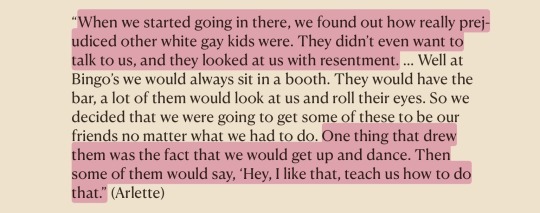


a Black fem (Arlette) & stud (Jodi) on racism from white butches & fems in the 1950s
from Boots of Leather, Slippers of Gold: The History of a Lesbian Community by Elizabeth Lapovsky Kennedy & Madeline D. Davis (1994)
excerpt 1:
“When we started going in there, we found out how really prejudiced other white gay kids were. They didn’t even want to talk to us, and they looked at us with resentment. … Well at Bingo’s we would always sit in a booth. They would have the bar, a lot of them would look at us and roll their eyes. So we decided that we were going to get some of these to be our friends no matter what we had to do. One thing that drew them was the fact that we would get up and dance. Then some of them would say, ��Hey, I like that, teach us how to do that.’” (Arlette)
excerpt 2:
Jodi remembers that the presence of Black studs made many white butches nervous: “Some of the stuff that happened was so typically racist, it was so ridiculous. I mean it was like Black studs were coming into the bar, people would just kind of put their arm around their women … [as if] they were just coming in there to snatch up their women.”
excerpt 3:
White lesbians also attended [house parties] but not in large numbers. This was resented by those Black lesbians who wanted a racially mixed community. “White kids started coming. Now they come up with, ‘that neighborhood,’ which I resent. Because there’s no such neighborhood that anybody’s gonna attack you. I get mad at that. ‘Well where do you live? I don’t want to come over there.’ What do you mean you don’t want to come over there?” (Arlette).
#butch/femme#stud/femme#queer history#racism#antiblackness#quotes#image described#boots of leather slippers of gold#mac’s bookshelf#at least 2 other narrators (a white butch & a stud) mentioned the racist comments about ‘neighborhoods’ but they were more tolerant of that#so i chose Arlette’s quote instead.#anyway the fact that white butches & fems only started talking to Black people at the bars when they wanted to benefit from Black dances?#possibly the singular most ‘holy fuck it’s just the same shit all the way back’ moment reading this book
26 notes
·
View notes
Text
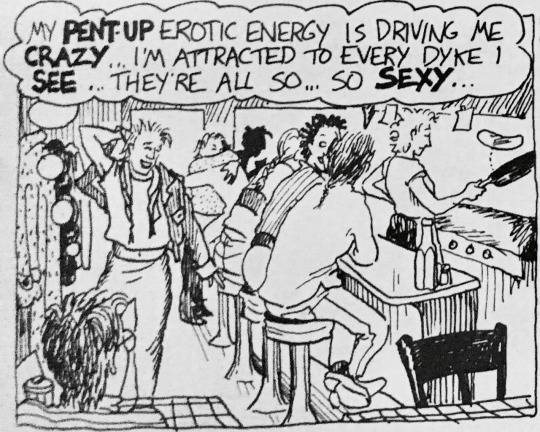
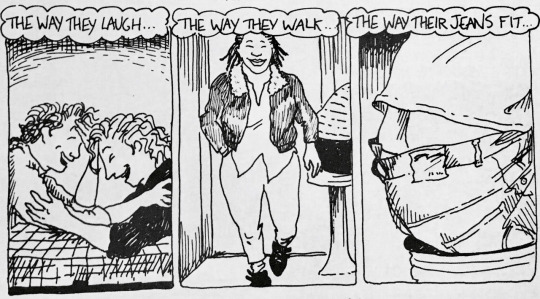
Dykes to Watch Out For by Alison Bechdel, 1987
#lesbian#wlw#butch4butch#butch4femme#lgbt#lgbtq positivity#lesbian couple#dykes to watch out for#transgender#transgender artist#trans#queer fashion#queer artist#queer history#lgbt history#sapphic#nblw positivity#femme4femme#stud dyke
370 notes
·
View notes